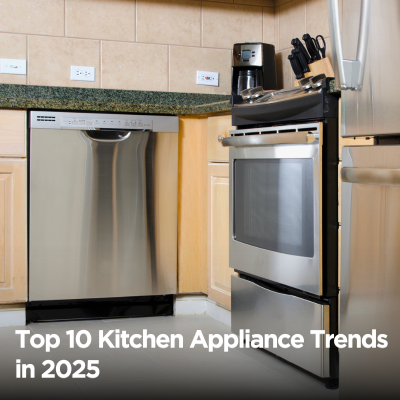The kitchen has become more than a space for cooking — it has become a big part of everyday living, where convenience, design, and technology meet. In 2025, kitchen appliances reflect new lifestyles and growing demand for smarter, more efficient homes.
From voice-activated ovens to energy-saving dishwashers, today’s appliances influence how people cook, clean, and organize their kitchens.
Keeping up with the latest kitchen appliance trends helps homeowners, chefs, and anyone upgrading their kitchen to make better choices.
With new features focused on sustainability, space-saving, and personalization, appliances are now built to support daily routines and long-term goals.
This guide includes the top 10 trends impacting 2025, offering helpful insight for anyone planning a functional, stylish, and future-ready kitchen.
Top 10 Kitchen Appliance Trends to Watch in 2025
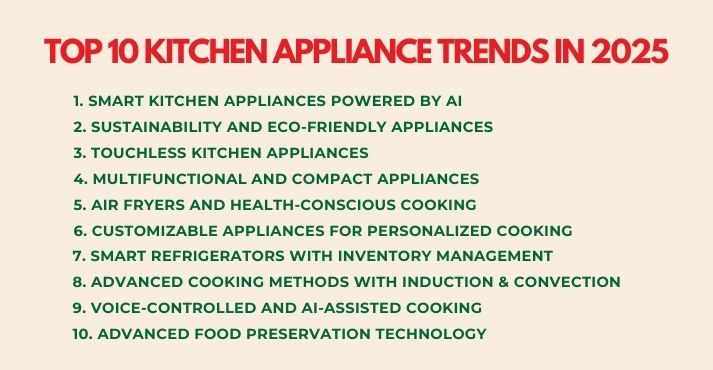
As we move through 2025, kitchens are seeing significant advancements with the latest appliance technology.
From smart gadgets that make cooking a breeze to eco-friendly innovations that reduce waste, these trends are already making their mark in kitchens worldwide.
Here are the top 10 kitchen appliance trends setting the pace for the rest of the year:
1. Smart Kitchen Appliances Powered by AI
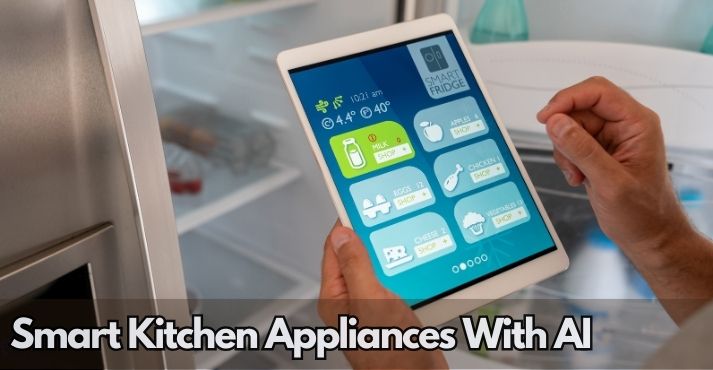
Smart appliances are no longer a futuristic concept; they’re very much a reality in 2025. AI-powered kitchen appliances, including smart fridges, ovens, and voice-controlled kitchen gadgets, have built-in voice assistants like Alexa and Google Assistant.
These devices help you easily control your appliances, whether you’re adjusting your oven’s temperature or checking the contents of your fridge from your phone.
The integration of Wi-Fi and Bluetooth allows for remote control via apps, offering convenience at your fingertips. In 2025, the Smart Appliances market is expected to generate US$68.7bn in revenue, indicating widespread use of smart technology.
These appliances offer convenience and enhance energy efficiency and personalization, simplifying everyday kitchen tasks like never before.
In short, modern kitchen technology is advancing, offering homeowners more efficient and intuitive ways to manage their kitchens.
2. Sustainability and Eco-Friendly Appliances
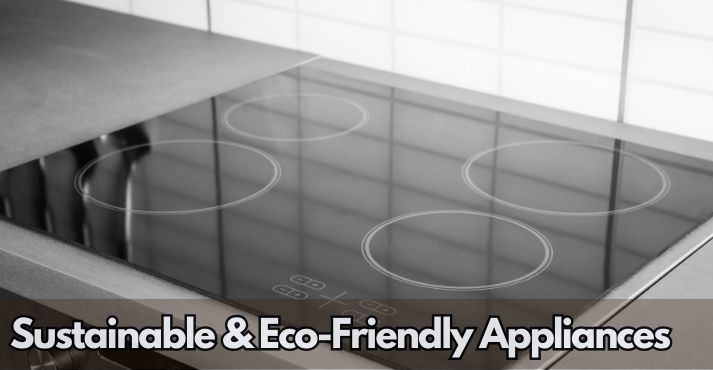
Sustainability remains a focus in 2025, with a clear emphasis on eco-friendly kitchen appliances.
Consumers are more conscious of the environmental impact of their home appliances, and manufacturers are responding with energy-efficient models designed to cut energy consumption and reduce waste.
New innovations, such as low-energy induction stoves, energy-efficient dishwashers, and composting kitchen gadgets, are helping homeowners create greener kitchens.
Energy-efficient appliances typically consume around 37% less energy than traditional models, making them an excellent choice for reducing energy consumption and lowering electricity bills.
With sustainability now a priority, eco-friendly kitchen solutions are essential elements of modern kitchen design, rather than just trends.
An example of this is the Bosch 800 Series Dishwasher. Certified by ENERGY STAR, these dishwashers consume approximately 239 kWh of energy annually, notably lower than many other models in the same category.
This reduction in energy usage helps lower electricity bills and reduce household carbon emissions.
3. Touchless Kitchen Appliances
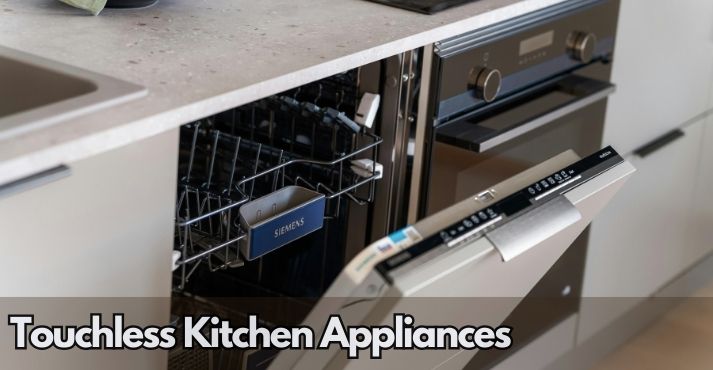
Touchless technology is becoming more common in kitchen appliances like faucets, dishwashers, and trash bins. Motion-sensor technology allows users to manage tasks without touching surfaces, improving hygiene and ease of use.
Touchless faucets and sensor-based dishwashers are especially popular for their ease of use and cleanliness.
A Consumer Reports survey reveals that around 80% of users value the convenience of motion-sensor technology, mainly when it allows them to control water flow without touching faucet handles.
As demand for a more hygienic and efficient kitchen experience grows, hands-free appliances are expected to become even more prevalent in 2025.
These types of food service equipment are becoming more common in commercial and home kitchens, thanks to their ability to simplify tasks and support better hygiene.
4. Multifunctional and Compact Appliances

As kitchen spaces get smaller, especially in urban areas, compact kitchen appliances that combine multiple functions are becoming more popular.
Today’s gadgets are designed to save space and time, from washer-dryer combos to multi-functional cooking devices like pressure cookers that also air fry. These space-saving kitchen gadgets help streamline daily routines without sacrificing performance or convenience.
Globally, interest in small yet powerful appliances is strong. The Small Appliances market is estimated to generate around US$266.30 billion in revenue in 2025, indicating that multifunctionality is in high demand.
Whether in apartments, condos, or compact homes, these appliances help users cook efficiently without taking up much room.
In home kitchens and the hospitality sector, efficiency and versatility are becoming essential, especially as demand grows for appliances that serve multiple purposes in limited spaces. This trend is also seen in the hospitality industry’s evolving equipment needs.
For example, the Ninja Foodi 9-in-1 Pressure Cooker and Air Fryer is a popular multi-functional appliance that combines pressure cooking, air frying, slow cooking, and more, making it a perfect fit for small kitchens or busy households.
5. Air Fryers and Health-Conscious Cooking
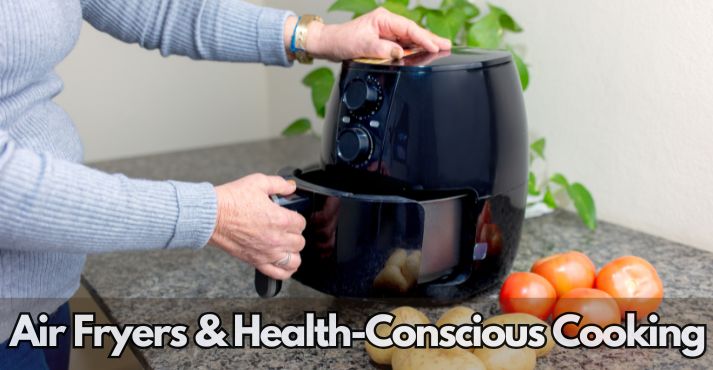
Air fryer trends are showing no signs of slowing down in 2025. These devices offer a quick and convenient way to enjoy crispy meals using low-oil cooking technology, making them a top choice for health-conscious home chefs.
Other health-focused cooking appliances like steamers, sous-vide machines, and slow cookers are also on the rise, supporting balanced eating habits.
An air fryer can cut calories by 70% to 80% compared to traditional deep frying, with significantly less fat. This makes it easier for people to prepare lighter versions of their favorite comfort foods without compromising flavor.
As consumers seek healthier options, these appliances are now considered innovative kitchen equipment that caters to modern wellness goals.
6. Customizable Appliances for Personalized Cooking
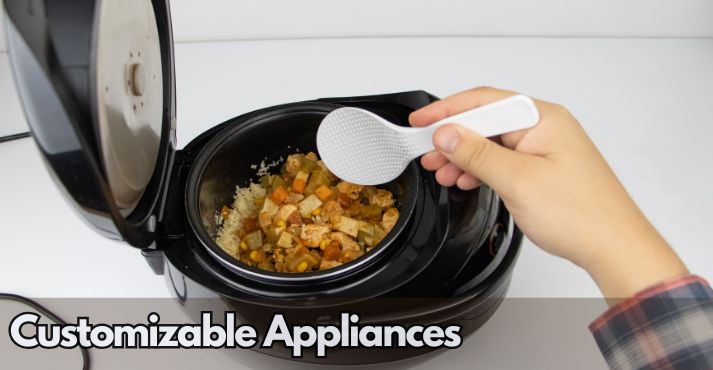
Kitchens these days are more personalized than ever. Appliance manufacturers are responding with customizable ovens, color-coordinated gadgets, and programmable cooking appliances.
These allow users to adjust temperature, humidity, and timing based on recipe needs or personal preferences.
This trend caters to people who want more control over how they cook, from setting exact temperatures for a roast to choosing the finish that matches their kitchen’s design.
These personalized kitchen gadgets add flexibility and convenience, whether you’re prepping a weekday meal or entertaining guests.
At the same time, this shift supports long-term efficiency. In professional settings, especially in restaurants and hotels, smart cooking devices and sustainable food service equipment offer personalization options to improve consistency and reduce waste.
An example is the GE Profile Smart Oven, which allows users to customize cooking settings with precise temperature control and pre-set recipes. This oven can be controlled remotely through a smartphone app, letting users adjust cooking parameters from anywhere.
7. Smart Refrigerators with Inventory Management
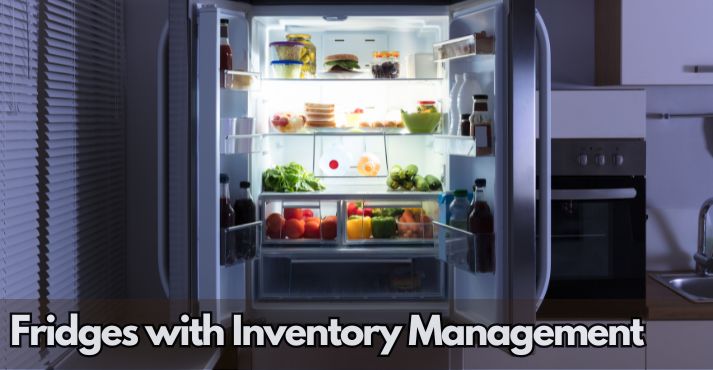
Smart refrigerators are changing the kitchen experience with advanced inventory management technology. These fridges track your food supplies, monitor expiration dates, and suggest recipes based on what you already have.
Some models even connect to your smartphone, allowing you to manage your inventory remotely and automatically order groceries when you’re running low, saving time and ensuring you never run out of essentials.
The largest share of the smart fridge sector is French door refrigerators, which account for 45% of the market, with widespread use in commercial and home kitchens. These fridges help keep your food fresh and streamline meal planning and shopping.
8. Advanced Cooking Methods with Induction and Convection Technology
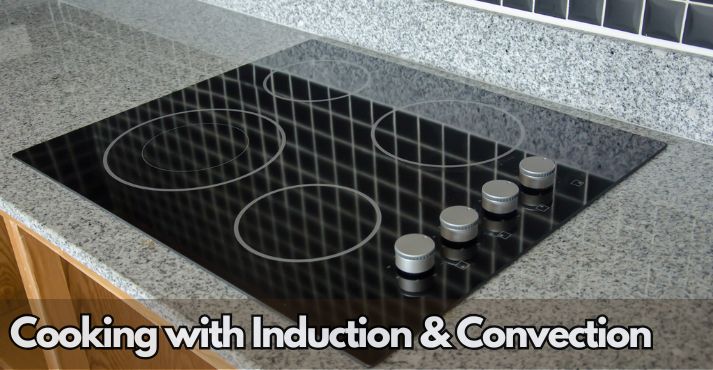
Induction cooktops and convection ovens are changing the way we approach precision cooking.
Induction stoves use magnetic fields to heat cookware directly, which makes them three times more energy-efficient than traditional gas stoves and 5%–10% more efficient than conventional electric units.
This means faster cooking times and less energy, making them a great choice for eco-conscious cooks.
Convection ovens are another must-have, circulating hot air for even heat distribution. They cook food evenly and faster, giving you perfect results every time.
Whether roasting a chicken or baking cookies, these appliances offer unparalleled speed and accuracy. These innovations are ideal for anyone seeking to improve their cooking efficiency.
9. Voice-Controlled and AI-Assisted Cooking

Voice-controlled kitchen appliances and AI-assisted cooking are changing how we prepare meals.
With voice-controlled smart kitchen assistants, you can adjust settings, start timers, and even find recipes with a simple voice command. No more fumbling with buttons or looking at screens with messy hands.
AI in cooking is also becoming more advanced, with appliances that can learn your cooking preferences and offer suggestions based on your habits.
From adjusting the temperature of your oven to notifying you when your dish is ready, AI helps ensure you achieve perfect results every time.
These technologies not only make cooking easier but also make kitchens more efficient and enjoyable.
For instance, the Brisk It Zelos 450 Smart Grill incorporates generative AI to automate cooking processes. It sends reminders for tasks like wrapping, and if ignored, it can automatically adjust the cooking temperature to keep things on track.
Its Smart Image Recognition can turn ingredient photos into recipes, while the Recipe Re-creation feature helps customize existing recipes specifically for grilling.
This integration of AI enhances the cooking experience by providing hands-free assistance and personalized meal preparation.
10. Advanced Food Preservation Technology
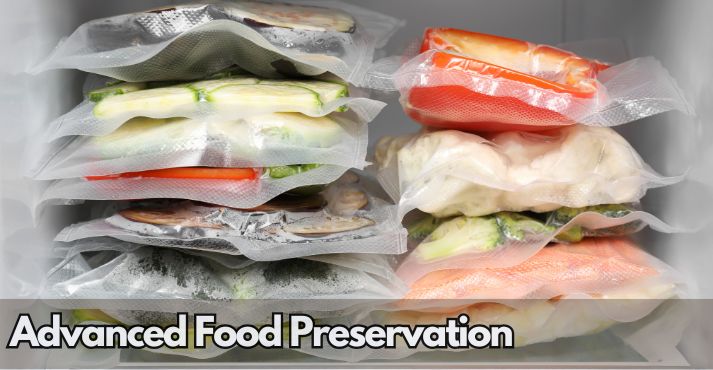
Food preservation technology is advancing rapidly, with innovations that extend shelf life, maintain freshness, and reduce waste.
Vacuum sealers are now equipped with advanced features that help preserve food by removing air and sealing it in airtight bags, preventing freezer burn and spoilage. Advanced refrigeration systems also keep food at optimal temperatures, ensuring freshness for longer.
These appliances are especially useful in home kitchens and the hospitality industry, where reducing food waste is a priority.
With extended shelf life appliances, chefs and home cooks can store ingredients more efficiently, saving money and minimizing waste. This is crucial for improving sustainability and maintaining high-quality ingredients.
Conclusion
As we progress through 2025, the kitchen appliance industry is seeing a surge of innovative trends that promise to make our cooking and kitchen management smarter, more efficient, and more sustainable.
Innovations are changing how we cook and use our kitchens, from smart refrigerators with inventory management to energy-efficient appliances like induction cooktops and convection ovens.
The demand for multifunctional, space-saving, and customizable appliances caters to the need for versatility in smaller spaces.
Sustainability continues to be a major focus, with eco-friendly appliances designed to reduce energy use and waste, highlighting the importance of environmental responsibility in homes.
Meanwhile, kitchens are becoming more convenient and personalized, with innovations like voice-controlled appliances and smart technology that make cooking tasks more straightforward and efficient.
To stay updated on the latest trends in kitchen technology and explore innovations, consider exploring the hospitality equipment trade shows.
These events showcase the advancements influencing the future of cooking and kitchen equipment, offering insights into the latest trends and innovations.

